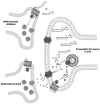Endocannabinoid-dependent modulation of phasic dopamine signaling encodes external and internal reward-predictive cues
- PMID: 25225488
- PMCID: PMC4150350
- DOI: 10.3389/fpsyt.2014.00118
Endocannabinoid-dependent modulation of phasic dopamine signaling encodes external and internal reward-predictive cues
Abstract
The mesolimbic dopamine (DA) system plays an integral role in incentive motivation and reward seeking and a growing body of evidence identifies signal transduction at cannabinoid receptors as a critical modulator of this system. Indeed, administration of exogenous cannabinoids results in burst firing of DA neurons of the ventral tegmental area and increases extracellular DA in the nucleus accumbens (NAcc). Implementation of fast-scan cyclic voltammetry (FSCV) confirms the ability of cannabinoids to augment DA within the NAcc on a subsecond timescale. The use of FSCV along with newly developed highly selective pharmacological compounds advances our understanding of how cannabinoids influence DA transmission and highlights a role for endocannabinoid-modulated subsecond DAergic activation in the incentive motivational properties of not only external, but also internal reward-predictive cues. For example, our laboratory has recently demonstrated that in mice responding under a fixed-interval (FI) schedule for food reinforcement, fluctuations in NAcc DA signal the principal cue predictive of reinforcer availability - time. That is, as the interval progresses, NAcc DA levels decline leading to accelerated food seeking and the resulting characteristic FI scallop pattern of responding. Importantly, administration of WIN 55,212-2, a synthetic cannabinoid agonist, or JZL184, an indirect cannabinoid agonist, increases DA levels during the interval and disrupts this pattern of responding. Along with a wealth of other reports, these results illustrate the role of cannabinoid receptor activation in the regulation of DA transmission and the control of temporally guided reward seeking. The current review will explore the striatal beat frequency model of interval timing as it pertains to cannabinoid signaling and propose a neurocircuitry through which this system modulates interoceptive time cues.
Keywords: cannabinoids; cues; dopamine; endocannabinoids; fixed interval; reward-seeking behavior.
Figures


Similar articles
-
Chronic Augmentation of Endocannabinoid Levels Persistently Increases Dopaminergic Encoding of Reward Cost and Motivation.J Neurosci. 2021 Aug 11;41(32):6946-6953. doi: 10.1523/JNEUROSCI.0285-21.2021. Epub 2021 Jul 6. J Neurosci. 2021. PMID: 34230105 Free PMC article.
-
Changes in nucleus accumbens dopamine transmission associated with fixed- and variable-time schedule-induced feeding.Eur J Neurosci. 2008 May;27(10):2714-23. doi: 10.1111/j.1460-9568.2008.06236.x. Epub 2008 May 29. Eur J Neurosci. 2008. PMID: 18513317
-
Cannabinoid receptor activation shifts temporally engendered patterns of dopamine release.Neuropsychopharmacology. 2014 May;39(6):1441-52. doi: 10.1038/npp.2013.340. Epub 2013 Dec 18. Neuropsychopharmacology. 2014. PMID: 24345819 Free PMC article.
-
Endocannabinoid modulation of dopamine release during reward seeking, interval timing, and avoidance.Prog Neuropsychopharmacol Biol Psychiatry. 2021 Jan 10;104:110031. doi: 10.1016/j.pnpbp.2020.110031. Epub 2020 Jul 12. Prog Neuropsychopharmacol Biol Psychiatry. 2021. PMID: 32663486 Review.
-
Endocannabinoid Regulation of Reward and Reinforcement through Interaction with Dopamine and Endogenous Opioid Signaling.Neuropsychopharmacology. 2018 Jan;43(1):103-115. doi: 10.1038/npp.2017.126. Epub 2017 Jun 27. Neuropsychopharmacology. 2018. PMID: 28653666 Free PMC article. Review.
Cited by
-
Expression and localization of CB1R, NAPE-PLD, and FAAH in the vervet monkey nucleus accumbens.Sci Rep. 2018 Jun 6;8(1):8689. doi: 10.1038/s41598-018-26826-2. Sci Rep. 2018. PMID: 29875385 Free PMC article.
-
Fischer 344 and Lewis Rat Strains as a Model of Genetic Vulnerability to Drug Addiction.Front Neurosci. 2016 Feb 9;10:13. doi: 10.3389/fnins.2016.00013. eCollection 2016. Front Neurosci. 2016. PMID: 26903787 Free PMC article. Review.
-
Cannabinoids and Schizophrenia: Risks and Therapeutic Potential.Neurotherapeutics. 2015 Oct;12(4):816-24. doi: 10.1007/s13311-015-0382-6. Neurotherapeutics. 2015. PMID: 26311150 Free PMC article. Review.
-
Co-occurring tobacco and cannabis use in adolescents: Dissociable relationships with mediofrontal electrocortical activity during reward feedback processing.Neuroimage Clin. 2021;30:102592. doi: 10.1016/j.nicl.2021.102592. Epub 2021 Feb 20. Neuroimage Clin. 2021. PMID: 33667977 Free PMC article.
-
Reduced Vglut2/Slc17a6 Gene Expression Levels throughout the Mouse Subthalamic Nucleus Cause Cell Loss and Structural Disorganization Followed by Increased Motor Activity and Decreased Sugar Consumption.eNeuro. 2016 Sep 29;3(5):ENEURO.0264-16.2016. doi: 10.1523/ENEURO.0264-16.2016. eCollection 2016 Sep-Oct. eNeuro. 2016. PMID: 27699212 Free PMC article.
References
-
- Bindra D. Neuropsychological interpretation of the effects of drive and incentive motivation on general activity and instrumental behavior. Psychol Rev (1968) 75:1–2210.1037/h0025306 - DOI
-
- Toates F. Motivational Systems. Cambridge: Cambridge University Press; (1986).
-
- Ferster CB, Skinner BF. Schedules of Reinforcement. New York: Appleton-Century-Crofts; (1957).
Publication types
LinkOut - more resources
Full Text Sources
Other Literature Sources
Miscellaneous

